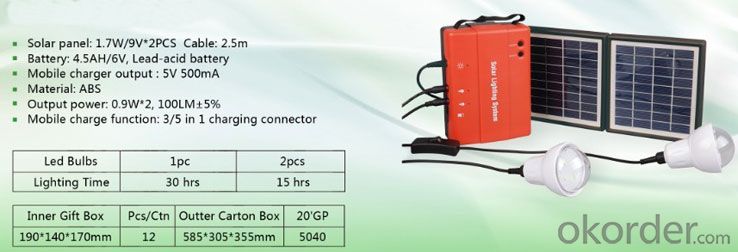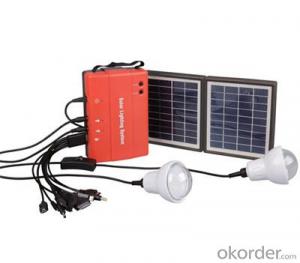MINI SOLAR LIGHTING SYSTEM
- Loading Port:
- Guangzhou
- Payment Terms:
- TT OR LC
- Min Order Qty:
- -
- Supply Capability:
- 10000 unit/month
OKorder Service Pledge
Quality Product, Order Online Tracking, Timely Delivery
OKorder Financial Service
Credit Rating, Credit Services, Credit Purchasing
You Might Also Like
Description:
Portable Solar Lighting System With 2 Lights
1, Foldable solar panels
3, USB mobile charging
Rechargeable by 3.4W solar panel
Body Material: ABS+PC
Battery: 4.5AH/6V Lead acid
Lighting time: 15 hours working after fully charged for 2 bulbs
Overcharge, over dischargeprotection controller
Accessory: 2 pcs of 0.9W LED bulbs with 5M long line cord each

- Q:Do solar energy systems work during cloudy days?
- Yes, solar energy systems can still work during cloudy days, although their efficiency may be reduced. While direct sunlight is the most effective way to generate electricity from solar panels, they can still produce power even with indirect or diffused sunlight. Cloudy days typically diminish the amount of sunlight reaching the panels, resulting in lower energy production. However, advancements in solar technology, such as the use of more efficient panels and improved light absorption, have made it possible for solar energy systems to generate electricity even in less ideal weather conditions. Additionally, solar systems are designed to capture and store excess energy during sunny periods, which can be utilized during cloudy days or at night.
- Q:Can a solar energy system be installed on a sports arena or stadium?
- Yes, a solar energy system can be installed on a sports arena or stadium. In fact, many stadiums around the world have already implemented solar panels to generate clean and renewable energy. These systems can be installed on rooftops, parking lots, or even integrated into the design of the stadium itself. Not only does this help reduce the carbon footprint of the facility, but it also helps offset energy costs and promotes sustainability in the sports industry.
- Q:Can solar energy systems be used in areas prone to earthquakes?
- Yes, solar energy systems can be used in areas prone to earthquakes. While earthquakes can pose a risk to any infrastructure, including solar panels, proper design and installation can mitigate potential damage. Reinforced mounting structures and flexible connectors can help absorb vibrations and prevent panels from dislodging. Additionally, solar energy systems are decentralized, meaning that even if some panels are affected by an earthquake, the rest of the system can continue to operate. Overall, with careful planning and engineering, solar energy systems can be used effectively in earthquake-prone areas.
- Q:Can solar energy systems be used in countries with low sunlight availability?
- Yes, solar energy systems can still be used in countries with low sunlight availability. While it is true that solar energy systems rely on sunlight to generate electricity, advancements in technology have made it possible to capture and utilize even small amounts of sunlight efficiently. Additionally, solar energy systems can be designed to incorporate other renewable energy sources, such as wind or hydroelectric power, to supplement low sunlight availability. Furthermore, using energy storage systems, such as batteries, can help store excess energy during periods of low sunlight and release it when needed. Therefore, even in countries with low sunlight availability, solar energy systems can still be a viable and sustainable option for generating electricity.
- Q:Can solar energy systems be installed on the ground?
- Yes, solar energy systems can be installed on the ground. In fact, ground-mounted solar systems are a popular choice for both residential and commercial applications. These systems typically consist of solar panels mounted on a structure or framework that is anchored to the ground. Ground-mounted systems offer several advantages over rooftop installations, such as increased flexibility in system design, easier access for maintenance and cleaning, and the ability to optimize the orientation and tilt angle of the panels for maximum energy production. Additionally, ground-mounted systems can be installed in areas with limited roof space or where the roof is not suitable for solar panel installation. Overall, ground-mounted solar energy systems provide a practical and efficient way to harness the power of the sun for electricity generation.
- Q:What is the role of solar charge controllers in regulating the charging of batteries?
- The role of solar charge controllers is to regulate the charging of batteries by managing the flow of current from the solar panels to the batteries. They ensure that the batteries are charged efficiently and safely by preventing overcharging, over-discharging, and other potential issues that could damage the batteries. Solar charge controllers also maximize the charging efficiency by adjusting the voltage and current according to the battery's needs, thereby extending its lifespan and optimizing its performance.
- Q:Can solar energy systems be used for agricultural applications?
- Yes, solar energy systems can be used for agricultural applications. They can power irrigation systems, provide electricity for farm equipment and machinery, and even support greenhouse operations by providing heating and lighting. Solar energy systems offer a sustainable and cost-effective solution for powering various agricultural activities.
- Q:How does the efficiency of solar panels vary across different panel sizes?
- Solar panels can have varying efficiency across different sizes due to multiple factors. Typically, larger panels exhibit higher efficiency compared to smaller ones. This is primarily because larger panels possess a greater surface area for capturing sunlight, thereby enabling them to generate more electricity. Larger solar panels have the capacity to accommodate more solar cells, responsible for converting sunlight into electricity. These additional cells augment the overall power output of the panel, resulting in increased efficiency. Furthermore, larger panels often possess better current and voltage ratings, allowing them to produce more electricity even in low light conditions. However, it is important to note that the size of solar panels does not solely determine their efficiency. The overall quality and technology of the panel also play a significant role. Manufacturers may employ different levels of technological advancements, materials, and manufacturing processes, all of which can affect the efficiency of their panels. Moreover, external factors such as temperature, shading, and installation angle can influence the efficiency of solar panels. Higher temperatures can reduce their efficiency, while shading from trees or buildings can significantly hinder performance. Additionally, the installation angle of the panels can impact their exposure to sunlight, thereby affecting overall efficiency. In conclusion, while larger solar panels generally exhibit higher efficiency due to their larger surface area and increased power output, other factors such as panel quality, external conditions, and installation angle can also influence efficiency across different sizes. It is imperative to consider all these factors when selecting the appropriate panel size for a specific application to ensure optimal performance and energy generation.
- Q:What is the role of power optimizers in solar energy systems?
- Power optimizers play a crucial role in solar energy systems by maximizing the efficiency and output of each individual solar panel. They help to mitigate the impact of shading, temperature variations, and panel mismatch, ensuring the system operates at its highest level of performance. Power optimizers also provide real-time monitoring and fault detection, enabling proactive maintenance and enhancing the overall reliability of the solar energy system.
- Q:Can solar energy systems be installed on sports stadiums?
- Yes, solar energy systems can be installed on sports stadiums. In fact, many stadiums worldwide have already adopted solar technology to harness clean and renewable energy. These systems can be mounted on stadium rooftops, parking lots, or even integrated into the design of the stadium itself. The use of solar energy in sports stadiums not only reduces their carbon footprint but also provides a sustainable and cost-effective solution for meeting their energy needs.
1. Manufacturer Overview |
|
|---|---|
| Location | |
| Year Established | |
| Annual Output Value | |
| Main Markets | |
| Company Certifications | |
2. Manufacturer Certificates |
|
|---|---|
| a) Certification Name | |
| Range | |
| Reference | |
| Validity Period | |
3. Manufacturer Capability |
|
|---|---|
| a)Trade Capacity | |
| Nearest Port | |
| Export Percentage | |
| No.of Employees in Trade Department | |
| Language Spoken: | |
| b)Factory Information | |
| Factory Size: | |
| No. of Production Lines | |
| Contract Manufacturing | |
| Product Price Range | |
Send your message to us
MINI SOLAR LIGHTING SYSTEM
- Loading Port:
- Guangzhou
- Payment Terms:
- TT OR LC
- Min Order Qty:
- -
- Supply Capability:
- 10000 unit/month
OKorder Service Pledge
Quality Product, Order Online Tracking, Timely Delivery
OKorder Financial Service
Credit Rating, Credit Services, Credit Purchasing
Similar products
New products
Hot products
Hot Searches
Related keywords




























